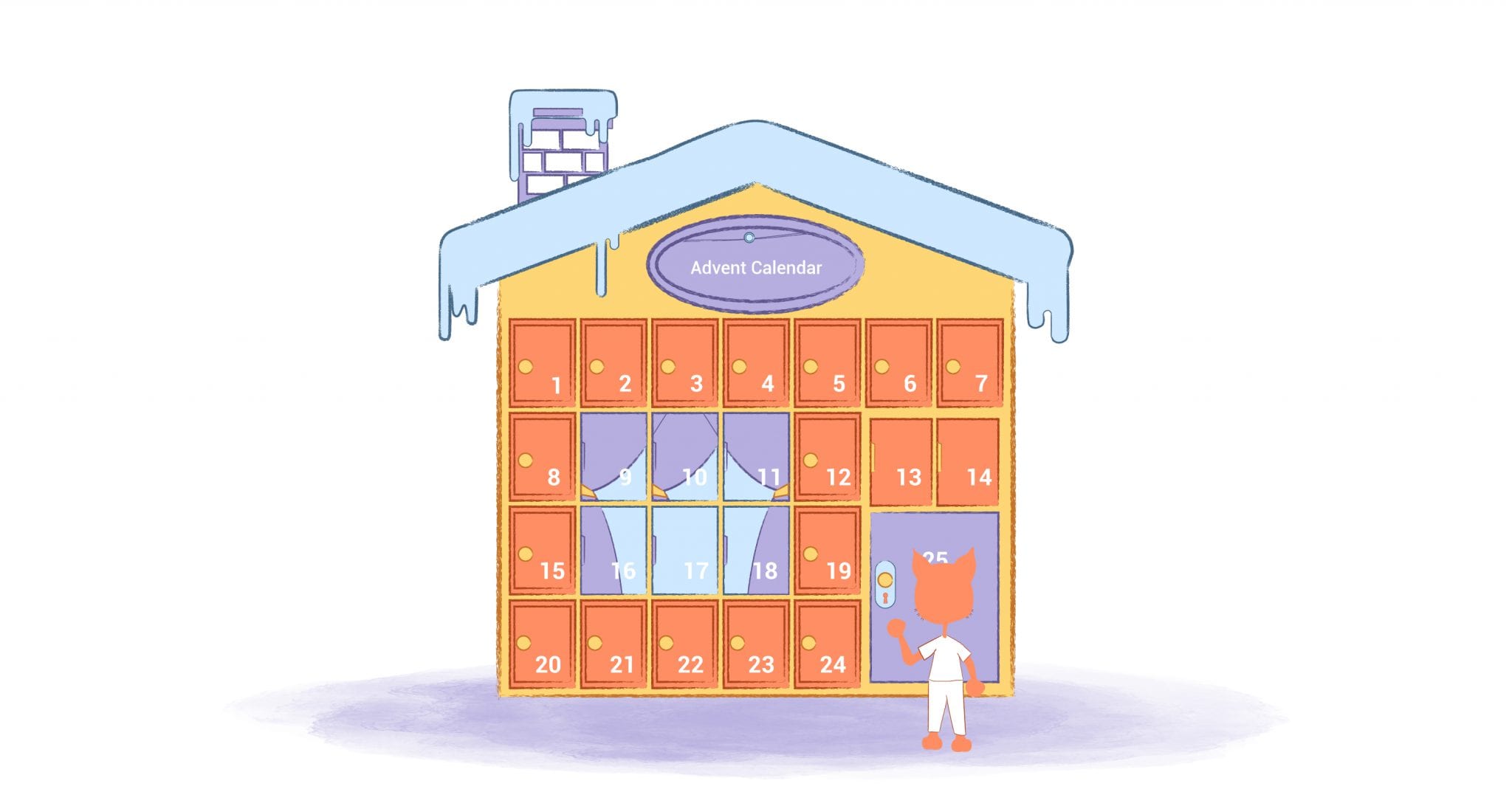

For those in the family that still eat meat — we’ve eaten the turkey and we’re full. As soon as the Thanksgiving dinner is over, I want to rush and start decorating for next month’s holidays. This year with COVID-19, I want to skip to January first, or at least to vaccine first — whenever that is. But we’re keeping the Advent Calendar.
There are a lot of ways to celebrate and enjoy any holiday season. One holiday tradition that many families use is called “the Advent” calendar. The traditional Advent Calendar counts the days from December 1st to December 24th. But, what exactly is an Advent calendar? Where did it originate, and how are we using advent calendars today?
We’re hopefully going to answer those questions, and more, in the following article.
What is an advent calendar?
The word advent comes from the Latin word adventus, meaning the arrival of a notable person, thing, or event. In Christian theology, advent refers to the next or second coming of Christ. But what exactly does this have to do with a calendar?
According to Got Questions, “Centuries ago, the importance of this event caused many Christians to feel that it was inadequate merely to mark off only one day on the yearly calendar for celebrating this incredible gift from God.” As a result, “they felt the need for a period of preparation immediately beforehand” to show their gratitude for the first Christmas.”They could then not only take time themselves to meditate on it, but also teach their children the tremendous significance of Christmas.”
This lead to the four-week period preceding Christmas that starts on the Sunday closest to St. Andrew The Apostle. Many people use an “advent calendar” to help people countdown and build excitement for a holiday on December 25.
As explained on DaySpring, “One window, page, or entry is designated for each day through Christmas Eve. Daily entries help tell the story, many with devotion or Scripture to reinforce the true meaning of Christmas for the whole family.”
The origins of advent calendars.
Historians aren’t exactly sure when people first began to celebrate Advent. Some historians believe that people in the 4th Century used this time to prepare for baptism when they converted to Christianity. Others claim that it was a little later and in the 5th Century when monks “began fasting thrice weekly in November, either to prepare for Christmas or Epiphany, during which new Christians were baptized each year.”
“But the timing of Advent was not routine until after Roman Emperor Constantine commemorated December 25 as Christ’s birthday during the fourth century. (The Eastern Church follows a different calendar, celebrating Christ’s birth on January 7.),” wrote Elizabeth Dias in Time.
The Advent calendars that we’re more familiar with appeared in the 19th Century. During this time, German Lutherans started to use lit candles or chalk marks on doors to mark the 24 days before Christmas.
“They first emerged in the mid-1800s as another tool to focus on the reason for the season,” adds Dias. “Before paper became readily available, many families used small candles or even blocks to mark each day approaching Christmas. Later, calendar doors opened to Bible verses that tell the Christmas story.” Over time, these paper doors would reveal images or objects like chocolate.
The first printed advent calendar.
Some people considered that the first Advent calendar was a handmade, wooden calendar made in 1851. In 1902, according to Weihnachtsmuseum, the oldest printed Advent calendar was a clock. “It is supposedly the ‘Christmas clock for children” from 1902 with rotating brass hand whose dial begins with 13 and whose panels mainly contain Christmas carol verses.
Just two years later, in 1904, a newspaper called Neues Tagblatt in Stuttgart, Germany, included an Advent calendar insert as a gift to its readers.
But in 1908, Gerhard Lang and his friend Reichhold opened a printing office. The cardboard Advent calendar influenced lang this his mother made for him as a child and began producing the first-ever printed Advent calendar. These calendars contained a small colored picture for each day in Advent. It was also Lang and Reichhold who came-up with the idea of adding small doors and windows to the calendars to help build excitement among children during the season.
Soon, other printing firms were manufacturing Advent calendars in the early 20th Century to meet demand. Unfortunately, the outbreak of World War I forced Lang and others to slow down production. But, production picked back up in the 1920s. Before World War II, Lang finally had to close his business for good. Having to close his company was a result of the combination of the rationing of cardboard and the Nazi ban on calendars that contained images.
The advent calendar goes international.
Thankfully, following the war, Richard Sellmer Verlag of Stuttgart was granted a permit from United States officials allowing his company to print and sell calendars once again in Germany.
By the 1950s, Advent calendars became increasingly popular around the world. President Dwight D. Eisenhower is credited for popularizing the calendar after Newsweek published photographs of him opening an Advent calendar with his grandchildren on Christmas morning.
Today, the company Richard Sellmer Verlag is still operating and supplies millions of Advent calendars to more than 30 different countries.
How advent calendars have changed with the times.
Although Advent calendars originally stemmed from Christian-themes, as the 20th Century went on, these calendars were marketed to assist children in counting down the days until Christmas. Nowadays, many celebrations in varying religions or holidays are accounted for with advent calendars. Celebrating all holidays, with all events and all religions is fun and might put a bright spot in the dim year.
For example, as Alissa Wilkinson notes for Vox, “The text accompanying the needlepoint Advent calendar sold by Lands’ End is typical of this marketing approach: ‘A little gift or treat every day can help kids get through the urgent days leading up to Christmas.’”
“Pockets in the calendar can be filled by parents with toys or treats, small gifts to satiate the excited child,” adds Wilkinson. Today, you can easily find Disney or Lego themed Advent calendars that used as marketing tools aimed at parents — for their children.
Advent calendars have also become common among “disposable-income-laden adults.” For instance, “there’s a calendar for Godiva chocolate, Diptyque scents, Ciaté London nail polish, and Revolution cosmetics. Or you can sample a variety of themed products: jerky, whiskey, gin, scotch, rum, craft beer, cheese, sex toys, and beard oil,” says Wilkinson.
That doesn’t mean that all Advent calendars have forgotten about their religious origins. There’s a Christian version called a “Jesse Tree” that combines the Christmas tree with an Advent calendar.
Interesting facts about advent calendars.
Want to know even more about Advent calendars? Here are seven interesting facts for you to enjoy. And, you may also want to use this knowledge to impress your friends and family throughout the holidays.
Start dates will vary.
Advent, according to most Western Churches, begins on the Sunday four weeks before Christmas Day. That means depending on the calendar for that year, the first day of Advent could be in late November or early December. In other words, Advent calendars do not always begin on December 1.
In the Eastern Orthodox Church, Advent is actually called the Nativity Fast. Because in most years, it begins in mid-November; it lasts closer to six weeks instead of four.
Sundays are very important.
In the church, each of the four Sundays on the Advent calendar has a special meaning that is related to topics like the Prophets, the Messiah, or John the Baptist. Sundays are so important that some churches will not permit funeral masses these days.
The third Sunday, however, is called Gaudete Sunday, and it’s a time to celebrate the arrival of Christ. It’s common to hear the clergy preach about joy and redemption and for Christians to reflect on what they’re grateful for.
The color violet.
Many of us associate red and green with the holiday season. However, the time before December 25 is all about violet and purple. The reason? These colors represent repentance and fasting. As such, it’s typical for priests to wear these colors and decorate churches with violet.
Observants light candles within an advent wreath.
It’s been the tradition to place four candles within an Advent wreath during this period. The wreath was meant to symbolize the immortality of the soul. The candles represent the four Sundays of Advent.
Advent calendars don’t have to be actual calendars.
We may think of Advent calendars as physical objects that you place in your home. The truth is that they don’t always have to be what we consider a calendar. For example, in Denmark, Finland, Iceland, Norway, and Sweden, it’s a tradition to also have a calendar in the form of a radio show or TV show.
There’s also a musical Advent calendar app from Naxos and design and coding advice web in the digital 24 Ways Advent calendar, which dispenses design and coding advice over the 24 days leading up to Christmas. With the emergence of voice calendars, there are ways to use Alexa as an Advent Calendar.
And, there are some places around the world that stage living Advent calendars. One such location is the English city of Henley-on-Thames. The most expensive advent calendar.
The most expensive advent calendar.
For some reason, in 2018, Mondial Pink Diamond Atelier unveiled the most expensive Advent calendar in the world. This handcrafted piece took 18-months to create and contains “specially selected, natural Australian timbers and embellished with precious gemstones, gold, and silver as well as hand-made, crystal chandeliers.”
How much is this calendar worth? Just a cool $4 million.
The most massive advent calendar.
According to Guinness World Records, “The largest advent calendar is 71 m (232 ft 11 in) high and 23 m (75 ft 5 in) wide and was built at St Pancras station, London, UK, to commemorate the station’s refurbishment in December 2007.”
On the other end of the spectrum, students and members of the University of Regensburg’s micro-and nanostructures group built the smallest Advent calendar in 2007. How small? Well, it would take five million of these calendars to fill a postage stamp. How to start an Advent calendar.
How to start an Advent calendar.
If you want to start your own Advent calendar, you may come across two different trains of thought. The first is that you would start with the highest number and countdown. In other words, you would count back from 24 to 1. The second is the calendar would begin with one and work up towards the highest number.
“If we are to use the historical context, it seems that the proper way to work through an advent calendar is starting on with the box labeled: one,” writes Kaitlyn Wylde in a Bustle article. “The point of the calendar is not to countdown, but rather to count up towards the days before Christmas.”
“Think about it this way: if you were going to use candles for your advent calendar, you’d want to end up with 24 lit candles, not one,” adds Wylde. “So, work your way up through your print calendar.”
With that out of the way, you next want to find an advent calendar. “The simplest can be posted on the wall, the fridge, or anywhere in your home; others range from tabletop devotionals to themed and decorative choices,” states DaySpring. Depending on your taste, these can be traditional or modern calendars that have already been made for you.
Personalizing your Advent calendar.
If you’re into DIY, you can also make your own Advent calendar. It doesn’t have to be too complicated. In fact, you want to keep things simple. The key is to make sure that you have the correct dates that align with the current calendar year. After that, you can use boxes, envelopes, or holiday shapes to represent the “dates.” You can then decorate them and fill them with whatever you like.
There are also digital Advent calendars, such as MyAdvent. You can upload whatever images you like and then add your own voice message or video for each “date” of the calendar. You can then share your calendar with family, friends, employees, or customers via email, social media, or a unique URL.
Regardless if you’re creating your own physical Advent calendar or using an online version, you’ll also want to personalize it. For example, you could add events and activities to each day of the Advent.
The addition of an advent calendar to your holiday celebrations might be any activity that is already scheduled in your December calendar plans — such as holiday parties or movies on TV. It’s an effective way to prevent scheduling conflicts during the hectic holiday season.
Finally, you don’t have to wait until the holiday season to use an Advent calendar. You could apply the concept to count up to a family vacation or product launch at your business. Each day leading up to the big event could include items to generate buzz. Let’s say your family is going to the beach. The four weeks before departing each day of the calendar could consist of things like sunscreen, sunglasses, and flip flops.











Deanna Ritchie
Editor-in-Chief at Calendar. Former Editor-in-Chief and writer at Startup Grind. Freelance editor at Entrepreneur.com. Deanna loves to help build startups, and guide them to discover the business value of their online content and social media marketing.